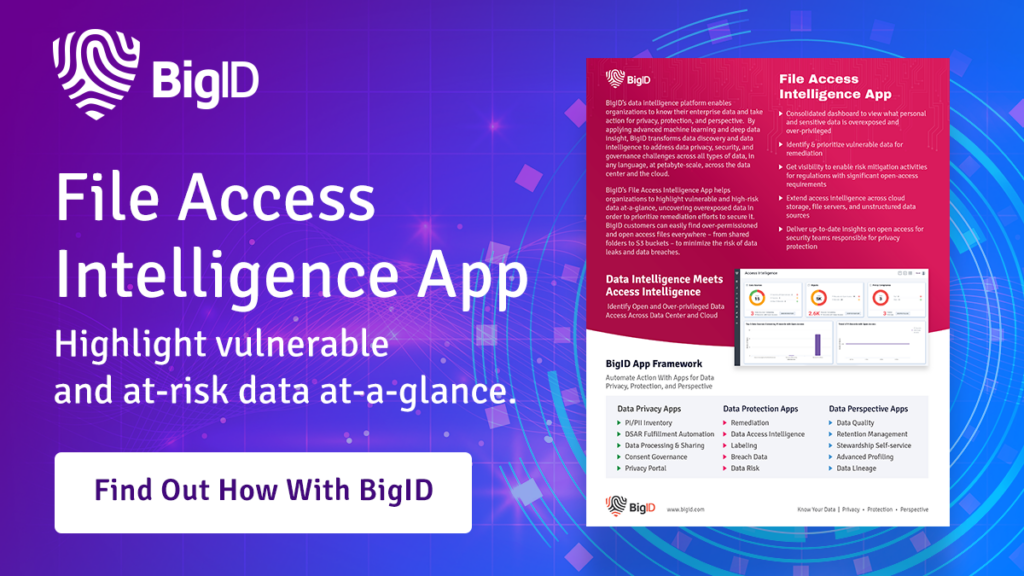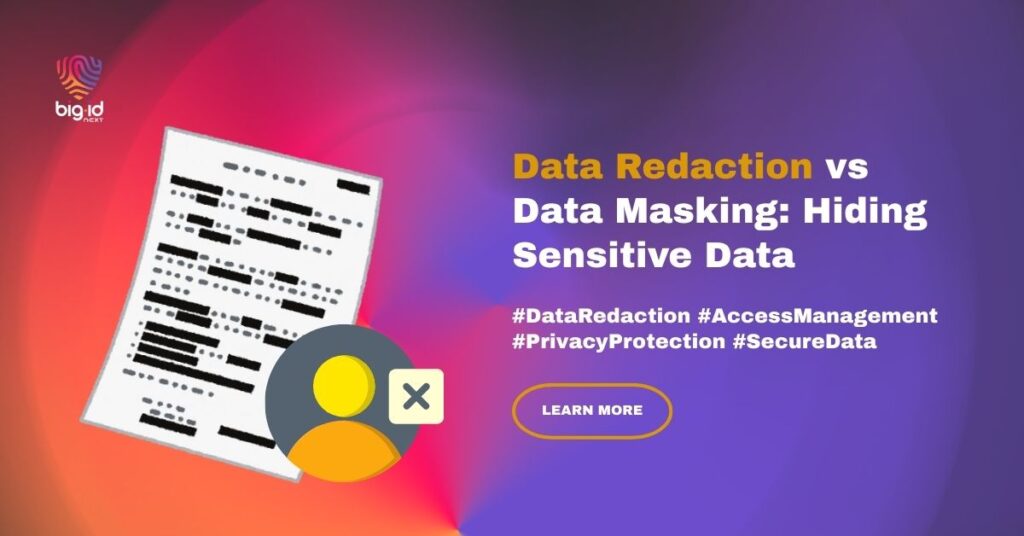As businesses, we collect and generate an immense amount of data. To get a sense of how much exactly, in 2024, the amount of information generated was 149 zettabytes (that’s 149 followed by 21 zeroes). The number is expected to go up to 394 zettabytes by 2028.
A lot of it is sensitive information, and, as such, needs to be protected from unauthorized access using a robust data protection strategy. Some of it can be put behind role-based access control (RBAC) and multi-factor authentication (MFA). However, certain use cases require you to share some personal data with others, while withholding parts of it to mitigate data exposure risks.
This is when data redaction involves more than just visual concealment; it plays a crucial role in data security and privacy compliance. In this context, it’s also important to understand the distinction between data redaction vs data masking, as each serves different security and compliance purposes.
What Is Data Redaction?
You might have seen movies and documentaries where, say, the CIA released a document, but with parts of it blacked out. That’s data redaction.
It’s the data security practice of permanently hiding or withholding personally identifiable, health, confidential, or sensitive personal information. When you do it on paper, the document can be shared with people who need to see some of the content but not all of it.
When done digitally, it can be customized according to the person’s role and needs. For example, you might want to share a customer’s email address with someone in the marketing department, but not their credit card details. Meanwhile, product dispatch doesn’t need any of that information, but they might need the home address to ship products to while ensuring data management practices are followed.
Effective data redaction is used in these scenarios to protect sensitive content without compromising operational efficiency or access to non-sensitive data.
Data redaction involves identifying and eliminating sensitive content in a way that ensures confidentiality while maintaining document usability where appropriate. It can also be helpful when sharing information with third parties. For example, you might want to withhold your IP address when sharing network logs to protect the details of your infrastructure.
Data Redaction vs Data Masking: The Two Data Privacy Methods
Both data redaction and data masking are methods of protecting sensitive information from those who shouldn’t have access to it. But how they do it is slightly different.
Data redaction, as we’ve seen, conceals the information completely. It “blacks out” anything that the viewer shouldn’t be allowed to see — including format and length.
Data masking, on the other hand, replaces the information with something else. For example, replacing each character with an asterisk or an X. The masked data maintains its format or data structure, which makes it useful in cases where the data still needs to be functional or realistic, but not revealed, thus supporting a comprehensive data privacy strategy. While encryption transforms data into an unreadable format that requires a key to decode, masking conceals the actual values in a way that keeps the data usable. With data redaction, the other party cannot see anything, while masking conceals the actual values.
The difference between data masking and redaction comes down to format preservation versus complete concealment. Masking is ideal for situations when you need the information to be functional and hold its shape, but you don’t want it seen, thereby reducing the risk of data breaches. It might be used to share information with developers, testers, and analysts who need the data but not personally identifiable information (PII).
Redaction, on the other hand, is more appropriate when any detail, including the length or format, could expose sensitive information. It offers a stronger level of protection by removing even contextual clues.
For example, if it’s a credit card number, everyone knows it’s 16 digits. You can hide the individual numbers, but it doesn’t matter if people can see how long it is. However, if it’s a medical diagnosis, even seeing part of the word or its length could allow someone to guess it.
When to Redact Data and What Types of Data to Redact
You need to redact sensitive data, which is usually protected by data privacy laws, but you also have an ethical responsibility towards your customers.
Of course, that’s relevant to what you collected from them; there’s also your sensitive business information.
Here’s a list of the data types you might want to redact:
- Personally identifiable information: This refers to anything that can identify the person it belongs to, whether on its own or by combining with other pieces of data. For example, a person’s social security number (SSN), passport number, full name (when combined with other information), etc.
- Protected health information: PHI is any medical information that’s protected by the Health Insurance Portability and Accountability Act (HIPAA). It includes medical record numbers, health plan beneficiary numbers, medical diagnoses, treatments, and conditions, etc.
- Financial information: This type of information includes credit or debit card numbers, bank account details, salary or compensation information, or tax identification numbers.
- Legal or government-related information: Names of witnesses or victims in a crime, juvenile information, identities of law enforcement officers, and sensitive testimony can be information that should be protected.
- Educational and research information: Any data that an educational institution collects about a student is covered by the Family Educational Rights and Privacy Act (FERPA), but information like research subject identifiers and experimental data linked to an individual is also sensitive information and should be redacted.
- Sensitive business information: You wouldn’t want to reveal trade secrets, proprietary formulas or algorithms, internal communications, or terms of contracts, which you may also want to redact.
- Classified information: In government, military, or regulated industries, safeguarding classified information is a non-negotiable use case for redaction.

Static vs Dynamic Redaction
As we’ve discussed, redaction is used to any data that’s not meant to be shared. How you do it depends on whether you’re doing it on paper, manually on a digital document, or using automation.
On paper, redaction is often just using a black marker over anything you want to obscure. Digital formats like PDFs also allow you to highlight over the text, although that’s proven to be ineffective more than once. However, it is possible to hide information in such documents using the “Redact” tool.
Of course, these are manual methods. If you’re an enterprise working with vast quantities of data, you would need to automate the process, because doing it manually is just not viable. There are several software programs and platforms that can automate redaction, including BigID. Simply provide the rules, and the tool will implement your data redaction policy. These redaction tools are being used across industries to streamline compliance and enhance security.
Static Data Redaction
Static redaction is a predefined, rule-based approach to protecting sensitive information. Here, sensitive information is permanently removed or obscured in a fixed version of the data, at the time of its export or when the document is prepared. Redaction is irreversible. Once redacted, the data is altered and cannot be restored. It’s typically used for documents or reports shared externally to share data securely.
Dynamic Data Redaction
Dynamic redaction occurs in real time, applying redaction logic when data is accessed, based on user roles or contextual rules. The original data remains unchanged in storage. However, it appears redacted to unauthorized users. This approach is commonly used in applications or dashboards where you need to conditionally hide sensitive information based on the viewer’s permissions.
How to Use Data Redaction: Techniques For Data Protection
A modern data redaction strategy includes data masking, obfuscation, and anonymization. As such, some of these techniques listed might fall under one of the other categories. However, they are still useful for helping you comply with data privacy regulations such as the General Data Protection Regulation (GDPR), California Consumer Protection Act (CCPA), or HIPAA.
- Blackout Redaction: Visually conceals sensitive information by overlaying black boxes or solid fills in documents, commonly used in legal and government records.
- Whiteout or Content Removal: Erases sensitive content by replacing it with blank space, eliminating visibility without disrupting the surrounding layout, which is essential for maintaining the integrity of private data.
- Pattern Matching and Replacement: Uses regular expressions or pattern detection to identify sensitive information and replace it with placeholder text like “REDACTED.”
- Character Substitution: Replaces characters in sensitive data with symbols (e.g., asterisks) while preserving some context, such as displaying only the last four digits of a credit card number.
- Data Tokenization: Converts sensitive values into random tokens that are meaningless without a secure mapping system, effectively hiding the original data.
- Shuffling: Anonymizes data by rearranging values within a dataset while maintaining the structure, commonly used in testing or analytics environments.
- Nulling Out: Removes sensitive information by replacing it with null or empty values, effectively wiping it from the dataset.
- Generalization: Replaces specific data with broader categories to reduce identifiability, such as changing exact birthdates to age ranges.
- Aggregation: Summarizes sensitive data into totals or group-level insights, minimizing the risk of identifying individuals and protecting sensitive or personally identifiable information.
- Pseudonymization: Substitutes identifying details with consistent pseudonyms or artificial identifiers, preserving data usability while protecting identities.
- Named Entity Recognition (NER) Redaction: Leverages AI and natural language processing to automatically identify and redact names, dates, and other entities in unstructured text.
- Rule-Based or Contextual Redaction: Uses custom rules or business logic to redact data depending on content type, sensitivity level, or user access.
- Metadata Redaction: Strips out hidden metadata like author names, document revisions, and comments to prevent unintentional data leaks.
- Database Field-Level Redaction: Redacts or hides specific fields in databases based on user roles or access policies, often in real time.
- Print-Based Redaction: Applies redaction to printed documents, often through manual review and physical redaction before scanning or archiving.
Each technique plays a role in ensuring sensitive data remains protected while enabling necessary access or analysis.
Data Redaction Use Cases
Your data redaction policy can be used for the following purposes:
- Compliance with data privacy regulations
- Securing sensitive customer information
- Protecting your internal company data
Apply Data Security With BigID
The BigID platform is a comprehensive way to protect sensitive data owned and stored by your business. Not only does it offer a number of enterprise data redaction and masking options, but it also gives you data discovery and mapping capabilities.
To find out all the ways in which this platform can help you with your data security and governance, schedule a demo today!



